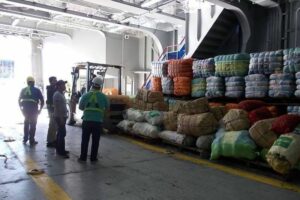
Domestic goods trade up 25.8% by value in 2023
THE domestic trade in goods rose 25.8% by value in 2023 reflecting higher domestic consumption and production amid inflationary pressures, the Philippine Statistics Authority (PSA) said on Wednesday.
According to the PSA’s final Commodity Flow in the Philippines report, the value of trade in domestic goods increased to P1.06 trillion. It had posted growth of 13.3% growth in 2022.
The volume of trade last year increased to 27.45 million tons, up 47.3%.
Domestic trade by value is the outflow value of commodities transported from the place of origin to the destination.
Commodity flow includes all goods transported by water, air, and rail, with shipping accounting for the bulk of the commodities.
“Domestic trade supported the resurgence of both domestic production and domestic demand in 2023. It appears that despite inflationary pressures in 2023, domestic production and domestic consumption maintained their upward trajectory,” University of Asia and the Pacific (UA&P) Senior Economist Cid L. Terosa said in an e-mail.
Inflation in 2023 averaged 6%, against 5.8% in 2022. The 2023 reading was the highest since the 8.2% posted in 2008 during the global financial crisis.
Mr. Terosa expects a robust domestic performance this year if inflation pressures are managed, and despite the possible impact of El Niño.
“Inflation and possible adverse consequences of external geopolitical tensions have the potential to dampen domestic trade this year,” he said.
In February, inflation accelerated to 3.4% from 2.8% in January, the highest reading in two months.
The National Capital Region had the largest trade balance last year amounting to P210.69 billion, followed by Central Luzon with P47.57 billion and Bicol region with P29.28 billion.
Metro Manila posted the highest trade value at P303.65 billion in 2023, followed by Central Visayas with P272.54 billion and Western Visayas with P137.55 billion.
The trade balance is the difference between the outflow value and inflow value. — Mariedel Irish U. Catilogo



